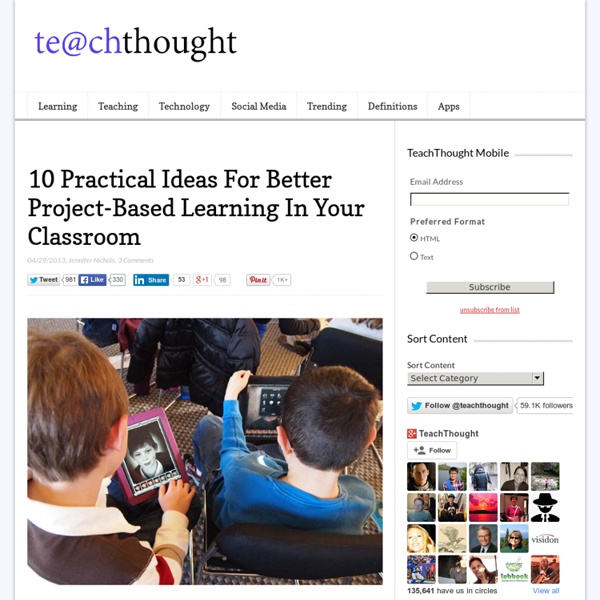Problem-Based Learning or Just Another Project? Use This Checklist to Find Out
A few days ago I posted Amy Mayer’s comparison between assigning projects and developing project-based learning in the classroom. Due to its immense popularity, I decided to do some more research on helpful charts for teachers trying to implement PBL in their classrooms, and was thrilled to come across this checklist from the good folks at BIE: This checklist is a fantastic way to ensure that you are on the right track with shifting away from “doing a project” and moving towards project-based learning. Even if you are still at the planning phase, this is a great graphic to get you thinking about the essential elements you should include in your next project-based learning unit! Happy checking, y’all! Like this: Like Loading...
Why English teachers should care about project-based learning: multiliteracies, assessment for learning and digital technologies. |
There is impetus for pedagogical change in the English classroom. Bull and Anstey (2010, p.6) observed that, ‘literacy teaching and learning should respond to the rapid changes in literacy arising from increasing globalization, technology and social diversity.’ This transforming social, cultural and technological landscape necessarily brings with it a new set of opportunities and challenges for secondary English teachers. Three such challenges include the purposeful integration of digital technologies into the classroom, the use of assessment for learning practices and the emergence of new literacies. The reshaping of traditional teacher-centred pedagogy to a more student-centred, inquiry-based pedagogy may assist Australian secondary English classroom with meeting these new challenges. One alternative pedagogy that may provide teachers with a scaffold to integrate digital technologies, assessment for learning practices and multiliteracies into the English classroom is PBL. Figure 1
11 Essential Tools For Better Project-Based Learning
by Katre Laan from myhistro.com The rise of technology used in classrooms has made learning much more interactive. The emergence of iPads to browser-based tools in project-based learning, take teaching to a new level in the 21st century. Even the current trends in education include the use of new technology, from collaborative projects to blending traditional textbook teaching with innovative tools. For students, the core aim of project-based learning is to put theory into practice and gain new skills throughout the process. A major advantage of digital tools used is better engagement in the classroom. Browser-based tools and several apps used in education are especially useful for researching, storytelling and collaborative video making. Handy mobile devices allow students to be inspired when outside classroom by creating and sharing ideas and creations instantly. Here is a mini guide to some of the project based learning tools. 1) Mindmeister 2) Glogster 3) Myhistro 4) Pixton 5) Animoto
Experts & NewBIEs | Bloggers on Project Based Learning: PBL Design Deep Dive –What Products, and How Many?
When designing a project, teachers frequently ask, “Should my students/teams create:The same product with the same focus or topic?”The same product, but with a different focus or topic?”A different product with the same focus or topic?"A different product, but with a different focus or topic?” As you have grown accustomed to in PBL, there is no ONE “right” answer to this question. The “same product with the same focus or topic” is often a good option in the elementary grades, or in the secondary grades when the project has a narrow scope of content and/or short duration. One project that fit this bill was a math project designed to teach systems of linear equations and processes to collect, organize and represent mathematical data. The teacher asked the driving question, “How can we develop an evidence-based recommendation to the White Rock Marathon Committee regarding the use of MP3 devices?” I worked with a teacher once who wanted to “PBLize” his persuasive writing unit.
What Teachers Need to Know about Authentic Learning
Authentic learning is learning in the "real world". It focuses on authentic deeds and students get to solve complex problems and find their solutions using a variety of activities like: role-playing, case studies, and collaborative peer learning. Authentic learning is idiosyncratic in its nature in that the setting where it takes place is multidisciplinary. In other words, the learning environment can be accommodated to foster different learning events. Now with the widespread of web technologies, more and more environments for authentic learning have been created. 1-Real-world relevance: Authentic activities match the real-world tasks of professionals in practice as nearly as possible. 2- Ill-defined problem: Challenges cannot be solved easily by the application of an existing algorithm; instead, authentic activities are relatively undefined and open to multiple interpretations, requiring students to identify for themselves the tasks and subtasks needed to complete the major task.
Practical PBL: The Ongoing Challenges of Assessment
In recent years, most students in my project-based AP Government classes have indicated, in both class discussions and anonymously on surveys, that they prefer project-based learning to a more traditional classroom experience. They find PBL more fun and believe that it leads to deeper learning. However, two types of students often resist this model. Students of the first type generally do not enjoy school at all, and are looking for the path of least resistance. Both types of students benefit from the option of choosing their role in project cycles to increase motivation. Fair Assessment of Teamwork To increase buy-in for both types of students, the most important thing a teacher needs to do is help build individual accountability -- and, by extension, trust -- in student teams. 1) Individual Skill Areas I have developed an individual semester portfolio as the most important measure of a student's skills assessment. 2) Role-Based Assessment 3) "Weighted" Scoring



